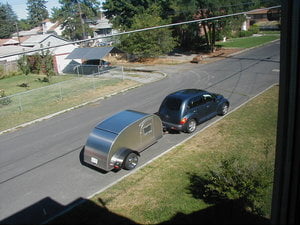Teardrop trailers have been around since the 1920’s. At times, they were manufactured for sale, but mostly they were home built. Free plans could be found in magazines such as Popular Mechanics and Scientific American. Today, most teardrops are still home built. This means they are a lot like snowflakes- no two are exactly alike. Some commercial companies still produce them, but the price can be prohibitive. Besides, nothing beats the satisfaction of doing it yourself.
There are different body styles for teardrops. Benroy is a boxy-looking design, while the traditional teardrop is much smaller. The term “teardrop” describes the basic aerodynamic shape of a teardrop, or airplane’s wing. One design was called “The Honeymooner,” a trailer the groom could build for his new bride. Teardrops have never cost a lot of money to build. Today, you don’t have to build the trailer. Many road-worthy trailers are available from different manufacturers.
Most teardrops are less than 48″ in interior height. They were made to be a sleeping compartment, not something you can walk around in. The inside is a bedroom, while the back end opens like a chuckwagon to reveal a kitchen. The small size means utilizing full sheets of plywood instead of complicated framing. Of course, you can get as complicated as you like, or as uncomplicated. Many folks have their teardrops wired for cable, wi-fi, shore power and just about any modern convenience you can imagine. Imagination is the only limit. The tear drop can be set up by one person. It can also double as a disaster bug out vehicle. For families with more than one vehicle, two or three teardrops can be built for your own private convoy or wagon train.
As long as your trailer passes inspection to be registered as a travel trailer in your state, you’re set. Check with your local DMV to learn the steps to registering your teardrop.
The following plan is inspired by one found in Vintageplans.com. The design is similar to a Benroy. Since I’m a woodworker and I want my own trailer, I’ll build my own before going to a larger trailer. Most cars can pull up to 1,000 lbs, and a teardrop weighs less than this. Many free, detailed plans are available online as well as plans you can purchase.
I decided to make mine as lightweight as possible. That means plastic cabinets and drawers instead of wood.
You will need:
- · Plywood sheets, ¾” and ½”
- · Plywood sheets, ¼” or luann plywood
- · Lumber: 2-by-4, 1-by-3, 1-by-2 and furring strips
- · Electrical tools
- · Woodworking tools
- · Pre-made trailer, either 5×8 or 4×8
- · Trailer stabilizers – 4 each
- · Trailer jack- 1 each
- · Drill and bolts, washers and nuts
- · Wood filler
- · Sandpaper
- ·(optional)
- · Hurricane hinge and latches for doors and hatch
- · Jigsaw to cut door
- · Galvanized wood screws, 2″ long
- · Construction adhesive
- · Corner aluminum for flashing
- · Aluminum trim for edges and corners- vinyl RV trim can be used as well
Step One:
Decide on the body type and size of trailer you will use. I’ve chosen a 4×8 folding utility trailer from Red Trailers.com. Assemble the trailer according to the directions. Weld, bolt or add wood to the frame to make it rigid.
Build a frame on top of the metal and attach with bolts. The floor and walls will be attached to the frame.
Step Two:
Attach one sheet of plywood to the frame for a floor. Lay two sheets of plywood out and design your top and side. It should curve to the back. Cut out the back. Cut several pieces of 1-by-2 for center braces, each 48″ long. Asking a friend for help is a good idea at this point.
Design and cut out the door from the side. Do not throw the cutout away- this is the door. Attach a hinge at the side, trim around the edge and flashing over the door to keep rain out. Attach a latch with a lock on the other side. This step can be done after the sides are up as well as now. Some teardrops have doors on both sides.
Cut out a space for an RV window. This allows for ventilation in the trailer. Some owners use an air conditioner, some install RV ceiling fans. It’s all up to you. The originals had neither; people still went camping.
Brace one side of the wall against the floor and frame. Attach with screws. Do the same on the other side. Attach the two walls at several points along the top with the 1-by-2’s. The plywood roof will attach to these braces.
Step Three:
Decide where you want the hatch to open. Mark this as a stopping point for your roof. You’ll build the hatch to fit the space.
Gently apply the plywood roof to the braces. Attach with short screws, about 1″ long.
Step Four:
Go inside the trailer. Map out where you want interior cabinets to be. Build them from ½” plywood. Even though I’ll be using plastic inserts for drawers, closets, etc., I still need the plywood to form the framing. It will also add strength and rigidity to the trailer.
Here’s the fun part. People stretch out with their legs under the back cabinets. The other side of the cabinets form the galley. It’s best to study a few plans while you design your cabinets, galley, closets, etc.
I’ll start my cabinets 6 feet from the front of my trailer cabin. Since I’m 5’2″ tall, I’ll have plenty of room to sleep and a place to stash extra gear.
About the galley:
- · The bottom cabinet is usually close, within a foot or so to the back of the trailer.
- · The next cabinet, which forms the workspace, is set back about a foot. The sleeper’s legs are under this cabinet.
- · The top cabinet attaches to the top inside of the cabin. Two cabinets can be built here- one for the galley and the other inside the cabin for storage, entertainment center and so forth.
Step Five:
Design and install your galley cabinets. Some owner/builders have drop in sinks, stovetops, 12-volt refrigerators, and much more. Others are pretty basic. Mine will be basic. A portable camp stove, a few jugs of water, a basin for washing dishes and I’m pretty much set.
Step Six:
Now for the not-so-much-fun part. The galley hatch must be built to fit exactly in the space or it will not work. If rain gets in, your trailer will be ruined. Build a frame from 1-by-3’s with 1-by-2 braces to fit in the space. Attach the roof, hinge at the top and try opening and closing it. Make certain it works. If not, remake it. Take your time with this step.
Trim the edges to keep the rain out. Attach the latch at the bottom. It’s a good idea to add gas lifts or something else to hold the hatch open while you’re using the galley. You can design and attach a shade for the outside to cook in the cool breeze.
Step Seven:
Apply wood filler to the inside floor, walls inside and outside of the trailer. You can install any type of flooring you like, it’s your trailer.
Some apply sheets of fiberglass to the outside for weatherproofing, others use marine products. I’ll use wood filler and outdoor paint. I’ll trim the corners and edges with RV trim. Over the plywood roof, I’ll apply PVC roofing for RV’s. A solar-powered boat vent will keep the inside air flowing. If it gets too hot, I’ll use a mini-air conditioner with 5,000 BTU’s. It draws less than 500 watts.
At the front of the trailer, I’ll build a battery box. Two 6-volt batteries wired for 12-volt power will take care of my electrical needs. If I eventually want to go to an RV park, I’ll add the appropriate electronics.
Using an air mattress inside also keeps the weight down. I can pull this trailer with a Mini Cooper. I don’t know about a Smart Car, though. Check with the manufacturer to see what it can do as far as towing anything.
Once the trailer passes inspection, gets a weight certificate and goes through the steps to be registered in the state of Texas, I’ll be able to load my teardrop and go. Since mine will be well under 1,000 lbs, I’ll be able to carry a little more gear.
Source: Staff Article, “Make Your Own Camping Trailer,” Vintage plans website, no date given





